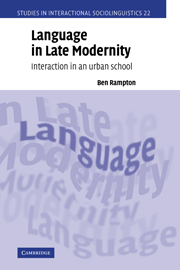Book contents
- Frontmatter
- Contents
- List of tables
- List of figures
- Acknowledgements
- Transcription conventions
- Part I Introduction
- 1 Late modern language, interaction and schooling
- Part II Urban classroom discourse
- Part III Performances of Deutsch
- Part IV The stylisation of social class
- Part V Methodological reflections
- References
- Index of names
- Subject index
1 - Late modern language, interaction and schooling
Published online by Cambridge University Press: 22 September 2009
- Frontmatter
- Contents
- List of tables
- List of figures
- Acknowledgements
- Transcription conventions
- Part I Introduction
- 1 Late modern language, interaction and schooling
- Part II Urban classroom discourse
- Part III Performances of Deutsch
- Part IV The stylisation of social class
- Part V Methodological reflections
- References
- Index of names
- Subject index
Summary
Outside education, research on classrooms is often seen as rather dull:
it takes a tremendous effort of will and imagination to stop seeing only the things that are conventionally ‘there’ to be seen … [I]t is like pulling teeth to get [researchers] to see or write anything beyond what ‘everyone’ knows.
(Becker 1971:10, cited in Delamont and Atkinson 1995:1)Delamont and Atkinson go further:
Becker's diagnosis is still a valid one in 1994 … [T]his is because the researchers have failed to read widely enough, have consequently lacked vision and imagination, and have thus failed to make any substantial contribution to sociology.
(1995:1–2)These are controversial claims, and this book does not offer an assessment of whether they are fair or not. But it does argue that if you get students to wear radio-microphones, if you adopt the methods of ethnographic and interactional sociolinguistics and readjust some of the working assumptions of descriptive analysis (accepting, contra Delamont and Atkinson, that part of the ‘blame’ lies with the feeder disciplines), then classroom proceedings take on a very different character.
Information
- Type
- Chapter
- Information
- Language in Late ModernityInteraction in an Urban School, pp. 3 - 38Publisher: Cambridge University PressPrint publication year: 2006
Accessibility standard: Unknown
Why this information is here
This section outlines the accessibility features of this content - including support for screen readers, full keyboard navigation and high-contrast display options. This may not be relevant for you.Accessibility Information
- 3
- Cited by
